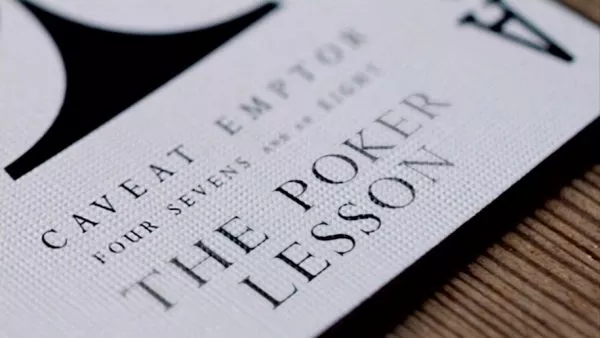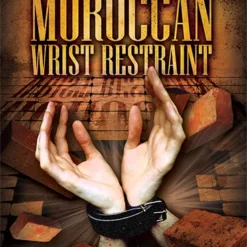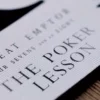Daniel Madison – Gamblers all 2 volumes (Gaffed deck not included)
40 $ Original price was: 40 $.6 $Current price is: 6 $.

Frequently bought together :
Magic Video

🔥 LIMITED-TIME OFFER: Master the art of deception with Daniel Madison’s Gamblers Vol. 1 & 2 – the ultimate toolkit for creating jaw-dropping card miracles without decades of practice! This isn’t just another gimmicked deck – it’s a revolution in modern card magic.
Why This Changes Everything
Imagine executing Royal Flush-level magic without complex sleights. When industry legends first witnessed Daniel’s methods, they refused to believe these weren’t advanced techniques perfected over lifetimes. The secret? A deck engineered to amplify your skills exponentially.
📌 Key Features:
✓ 50+ precision-crafted utility gaffs working seamlessly with Black Rounders/Green Dealers
✓ 15+ professional routines pre-loaded on instructional DVD
✓ Never-seen-before concepts that redefine “impossible” card magic
✓ Certified by Brad Christian, Alex Pandrea & other industry giants
Manipulate Reality Like Never Before
This isn’t magic – it’s strategic warfare against skepticism. While purists debate technique, you’ll be:
• Executing flawless center deals that defy physics
• Vanishing cards under direct scrutiny
• Predicting poker hands with 100% accuracy
• Swapping entire hands faster than the eye perceives
Inside the Master’s Mind
“Why waste years mastering movesnwhen these cards make you look like you already did?” – Daniel Madison
Developed through 20+ years of underground gambling demonstrations, every card serves as both weapon and shield. The Madison Gamblers don’t just teach magic – they install professional-grade deception software into your performances.
Featured Routines
💎 The Nuclear Arsenal:
• BlackJack Matrix: Deal perfect hands like a Vegas pro
• Royal Switch: Seamless flush transformations
• Stolen Card: Burglarize cards mid-performance
• Cut Card Trilogy: 3 devious methods to control outcomes
⚠️ Warning: These techniques are so convincing, audiences may genuinely believe you’ve sold your soul at the crossroads.
🚨 Your Magic Just Leveled Up
23 students are viewing this RIGHT NOW – don’t let them grab the last copy! This deck vanishes faster than your credibility without it.
—-

Exclusive offer: Daniel Madison – Gamblers all 2 volumes (Gaffed deck not included) is now available! Enhance your magic skills today.
Description
When Brad originally saw Daniel perform the Royal Flush Sequence (seen in the trailer) he thought this was Daniel just doing what Daniel does. A gamblers cop, switch and some lapping. But there was no switch. There wasn’t even a gamblers cop. It was all gaffs.
Somehow, Daniel Madison has taken a lifetime of hard-earned skills, and packed them into a single deck of utility gaffs that can be used to create near miracles at the card table.
Gamblers are a never-before-seen concept in Gaff Playing Cards. These are precision made gaffs for use with Black Rounders and Green Dealers, to enable you to perform effects that would otherwise take a lifetime to master.
Every single card has been carefully thought out and designed by Daniel to fly under the radar, enhancing your skills and making you seem like a master.
Daniel has created these cards to be utilities that you can use to develop your own routines. More than 15 individual routines are included on the explanation DVD – but the possibilities with this deck are endless.
Gamblers Gaffs have been created for demonstrations of seriously advanced sleight of hand for any performer. They won’t create a brilliant presentation for you, but, slipped in occasionally to a demonstration they will allow a few minds to be shattered. Especially those who watch with a knowing eye.
We recognize that there are sleight of hand purists who may say that a gambling demonstration should be something achieved with a standard deck of cards and pure skill. If that’s your belief then we invite you to start on Disc 2 of this set. You can hear what Alex Pandrea, Brad Christian, Tony Chang, and many others have to say about it.
When method is put as the priority of the performance, at the expense of the audience’s perception, then you have missed the point of performance. What matters is what is perceived by the audience.
Perception is Reality – or in the words of Daniel Madison, “If there’s a deck that makes a move ten times easier, and it makes me look ten times better, then you’re damn right I’m going to use cards like this…”
A Note from Daniel Madison
Of all of the things that can be achieved by difficult sleight-of-hand, when taken out of their intended purposes for the sake of demonstration or performance, there is a fine line between actual and pseudo executions.
Over the years I have collected ideas on how to achieve near-impossible sleights without the necessary work, simply for the sake of demonstrations and pseudo exposure. Some of these ideas are methods disguised as other methods, and the others, are gaff playing cards that are never seen by the onlooker. Those ideas became the Madison Gamblers.
People may argue that gambling is an art form of intricate and difficult sleight-of-hand, and that demonstrations should be truthful, and I would agree, however, gambling was not made to be exposed or demonstrated and so exposure of gambling has itself become a new art, constantly demonstrated by people, most of whom have never played a game of cards let alone executed an illegal move at one.
The Madison Gamblers are for the demonstrators, for those who want to showcase an intricate skill in order to make their exposures far better and far more believable. They are under the radar, they will never be seen, and with these, your reputation as a gambler will reach great new heights.
THE DECK.
THE EFFECTS.
Dice – The only gaff in the entire deck that stands out as a ‘gimmicked card’. A standard die transforms into a paper die in the action of being thrown. When unfolded, the die’s construction paper turns out to be a previously selected card.
• 2 Card Monty – Utility cards that allow for the performance of the myriad of Two and Three Card Monte effects that abound. Daniel teaches his handling for both a tabled and in-the-hands version.
• BlackJack – A truly phenomenal demonstration that combines center dealing two cards from different places in the deck in a single deal, with an invisible palm and muck/switch. Deal yourself the perfect blackjack hand (almost) every time.
• Replacement Ace – A game of poker is dealt to the number of hands named by a spectator. While the spectator receives a very strong hand, they are of course beaten by the performer. A fact predetermined by the writing on the Ace of Spades.
• Replacement Joker – The same basic effect as Replacement Ace, only this time the spectator is accidentally dealt a joker as part of their hand – a card which they obviously discard. The effect is possibly stronger, given the writing was in front of the spectator the entire time.
• The Poker Lesson – A Sam-the-Bellhop style of effect that makes sense in a gambling demonstration, teaching the ranking of poker hands to a spectator. The method for this effect also opens itself to memory recall presentations, included but not limited to card at any number.
• Stolen Card – A card is chosen and returned to the deck. The performer deals a poker hand to the table, and confirms with the spectator that their card is amongst those dealt. In the act of squaring the pack, the chosen card is stolen invisibly, to be dealt from the pack whenever the performer decides.
• Straight Switch – The performer attempts to demonstrate crooked dealing, aiming for a straight poker hand, however misses completely. The hand is squared, and invisibly switched for the correct cards – the named straight now in the performers hand.
• Royal Switch – Similar to the Straight Switch, the performer misses dealing the winning hand. With a switch, he swaps the incorrect cards for the Royal Flush – the incorrect cards being returned invisibly to the top of the pack.
• Cut Card i – A utility cut card that supposedly makes bottom dealing impossible. As this card is printed on card stock, it is easy to manipulate. Daniel shows how he uses it to Greek Deal the four Aces, and how to apparently prove you have a photographic memory.
• Cut Card ii – Daniel demonstrates a number of ways to use the cut card as a stab card to present a prediction effect, a switch or a center deal with an indicated card.
• Cut Card iii – An idea from Mark Calabrese. The cut card is placed on top of the face up deck. In a move that beggars belief, the card below the cut card is topshot from beneath the cut card into the hand. This effect will have your audience doing repeated double takes. Daniel also teaches a method that allows you to vanish a single card from under the cut card in the hands.
• Center Deal – Four Aces are placed face up in separate places throughout the face-down deck. The deck is spread both Face Up and Face Down to show the position of the cards. Cleanly and fairly, the four aces are dealt, one at a time, from their respective places in the deck. The deck is spread to show the aces have indeed been dealt cleanly, and that there are no duplicates.
• Middle Deal – The four aces are dealt from the top of the deck to the table, before being put face down into separate positions throughout the facedown deck. Again, they are dealt fairly to the table – each having come from the middle of the deck. The deck is spread to verify they have truly been dealt.
Shipping Policy
All products are digital, and you can download them immediately.
If there is no download file available, please allow 1-2 days* for processing (as we have a large number of files, it may take time to locate them).
Order Changes
Once your order has been confirmed, it cannot be modified or canceled. If you wish to return a product due to an incorrect order or long waiting time, you may exchange it for another product. Please contact us via email.
Return & Refund Policy
If you want to return an item to Magicteachingcenter, please follow the instructions below within 3 days of delivery. Please contact customer service.
Contact us for return instructions:
Email: [email protected]
Regular products can be returned for a refund, replacement, or credit hold, while special or custom products can only be returned for exchange.
Once the Fulfillment Center has received and confirmed your return (usually within 72 hours of receipt), you will receive an email confirming that your return is complete. If a refund is applicable, it will be processed within 7 days. Please note that, depending on your bank, it may take an additional 3-5 business days for the credit to appear in your account.
Have any questions?
The Magicteachingcenter team is happy to assist you!
Email us at: [email protected]
Be the first to review “Daniel Madison – Gamblers all 2 volumes (Gaffed deck not included)” Cancel reply
You must be logged in to post a review.
 Magic World – Moroccan Wrist Restraint ( Instant Download )
Magic World – Moroccan Wrist Restraint ( Instant Download ) 
![[Magic Video] Worlds Greatest Magic - Gambling Routines with Cards Vol 2 ( Instant Download ) [Magic Video] Worlds Greatest Magic - Gambling Routines with Cards Vol 2 ( Instant Download )](https://magicteachingcenter.com/wp-content/uploads/2024/03/wggamblingcards_vol2-full.webp)
![[Magic Video] Ring String And Ding by Paul Hyland [Magic Video] Ring String And Ding by Paul Hyland](https://magicteachingcenter.com/wp-content/uploads/2024/01/paul20hyland20-20ring20string20and20ding-247x247.webp)
![[Magic Video] Jay Mattioli - Renaissance FX [Magic Video] Jay Mattioli - Renaissance FX](https://magicteachingcenter.com/wp-content/uploads/2024/01/jay20mattioli20-20renaissance20fx-247x247.webp)

Reviews
There are no reviews yet.